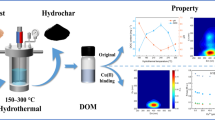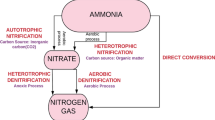Abstract
In this study, the process of pyrite colonization and leaching by three iron-oxidizing Acidithiobacillus species was investigated by fluorescence microscopy, bacterial attachment, and leaching assays. Within the first 4–5 days, only the biofilm subpopulation was responsible for pyrite dissolution. Pyrite-grown cells, in contrast to iron-grown cells, were able to oxidize iron(II) ions or pyrite after 24 h iron starvation and incubation with 1 mM H2O2, indicating that these cells were adapted to the presence of enhanced levels of reactive oxygen species (ROS), which are generated on metal sulfide surfaces. Acidithiobacillus ferrivorans SS3 and Acidithiobacillus ferrooxidans R1 showed enhanced pyrite colonization and biofilm formation compared to A. ferrooxidans T. A broad range of factors influencing the biofilm formation on pyrite were also identified, some of them were strain-specific. Cultivation at non-optimum growth temperatures or increased ionic strength led to a decreased colonization of pyrite. The presence of iron(III) ions increased pyrite colonization, especially when pyrite-grown cells were used, while the addition of 20 mM copper(II) ions resulted in reduced biofilm formation on pyrite. This observation correlated with a different extracellular polymeric substance (EPS) composition of copper-exposed cells. Interestingly, the addition of 1 mM sodium glucuronate in combination with iron(III) ions led to a 5-fold and 7-fold increased cell attachment after 1 and 8 days of incubation, respectively, in A. ferrooxidans T. In addition, sodium glucuronate addition enhanced pyrite dissolution by 25 %.








Similar content being viewed by others
References
Abramoff MD, Magalhaes PJ, Ram SJ (2004) Image processing with ImageJ. Biophoton Int 11:36–42
Amouric A, Brochier-Armanet C, Johnson DB, Bonnefoy V, Hallberg KB (2011) Phylogenetic and genetic variation among Fe(II)-oxidizing acidithiobacilli supports the view that these comprise multiple species with different ferrous iron oxidation pathways. Microbiology 157:111–122
Barahona S, Dorador C, Zhang R, Aguilar P, Sand W, Vera M, Remonsellez F (2014) Isolation and characterization of a novel Acidithiobacillus ferrivorans strain from the Chilean Altiplano: attachment and biofilm formation on pyrite at low temperature. Res Microbiol. doi:10.1016/j.resmic.2014.07.015
Barreto M, Gehrke T, Harneit K, Sand W, Jedlicki E, Holmes D (2005) Unexpected insights into biofilm formation by Acidithiobacillus ferrooxidans revealed by genome analysis and experimental approaches. In: Harrison STL, Rawlings DE, Petersen J (Eds) Proceedings of the 16th International Biohydrometallurgy Symposium Compress, Cape Town, pp 817-825
Bellenberg S, Diaz M, Noel N, Sand W, Poetsch A, Guiliani N, Vera M (2014) Biofilm formation, communication and interactions of leaching bacteria during colonization of pyrite and sulfur surfaces. Res Microbiol. doi:10.1016/j.resmic.2014.08.006
Bellenberg S, Leon-Morales CF, Sand W, Vera M (2012) Visualization of capsular polysaccharide induction in Acidithiobacillus ferrooxidans. Hydrometallurgy 129–130:82–89
Bellenberg S, Vera M, Sand W (2011) Transcriptomic studies of capsular polysaccharide export systems involved in biofilm formation by Acidithiobacillus ferrooxidans. In: Qui G, Jiang T, Qin W, Liu X, Yang Y, Wang H (eds) Biohydrometallurgy: biotech key to unlock mineral resources value proceedings of the 19th International Biohydrometallurgy Symposium Central South University Press. Changsha, China, pp 362–365
Borda MJ, Elsetinow AR, Schoonen MA, Strongin DR (2001) Pyrite-induced hydrogen peroxide formation as a driving force in the evolution of photosynthetic organisms on an early Earth. Astrobiology 1:283–288
Brierley CL, Brierley JA (2013) Progress in bioleaching: part B: applications of microbial processes by the minerals industries. Appl Microbiol Biotechnol 97:7543–7552
Chiume R, Minnaar SH, Ngoma IE, Bryan CG, Harrison STL (2012) Microbial colonisation in heaps for mineral bioleaching and the influence of irrigation rate. Miner Eng 39:156–164
DEV (1989) DIN 38 406: Deutsche Einheitsverfahren zur Wasser-, Abwasser- und Schlammuntersuchung; Kationen (Gruppe E), Teil 1 Bestimmung von Eisen (E1), Normenausschuss Wasserwesen im DIN Deutsches Institut für Normierung eV: 22 Lieferung 1989
Farah C, Vera M, Morin D, Haras D, Jerez CA, Guiliani N (2005) Evidence for a functional quorum-sensing type AI-1 system in the extremophilic bacterium Acidithiobacillus ferrooxidans. Appl Environ Microbiol 71:7033–7040
Flemming HC, Wingender J (2010) The biofilm matrix. Nat Rev Microbiol 8:623–633
Freitas F, Alves VD, Torres CAV, Cruz M, Sousa I, Melo MJ, Ramos AM, Reis MAM (2011) Fucose-containing exopolysaccharide produced by the newly isolated Enterobacter strain A47 DSM 23139. Carbohyd Polym 83:159–165
Gehrke T, Telegdi J, Thierry D, Sand W (1998) Importance of extracellular polymeric substances from Thiobacillus ferrooxidans for bioleaching. Appl Environ Microbiol 64:2743–2747
Gonzalez A, Bellenberg S, Mamani S, Ruiz L, Echeverria A, Soulere L, Doutheau A, Demergasso C, Sand W, Queneau Y, Vera M, Guiliani N (2012) AHL signaling molecules with a large acyl chain enhance biofilm formation on sulfur and metal sulfides by the bioleaching bacterium Acidithiobacillus ferrooxidans. Appl Microbiol Biotechnol 97:3729–3737
Hallberg KB, Gonzalez-Toril E, Johnson DB (2009) Acidithiobacillus ferrivorans, sp. nov.; facultatively anaerobic, psychrotolerant iron-, and sulfur-oxidizing acidophiles isolated from metal mine-impacted environments. Extremophiles 14:9–19
Harneit K, Göksel A, Kock D, Klock JH, Gehrke T, Sand W (2006) Adhesion to metal sulphide surfaces by cells of Acidithiobacillus ferrooxidans, Acidithiobacillus thiooxidans and Leptospirillum ferrooxidans. Hydrometallurgy 83:245–254
Hedrich S, Johnson DB (2013) Acidithiobacillus ferridurans sp. nov., an acidophilic iron-, sulfur- and hydrogen-metabolizing chemolithotrophic gammaproteobacterium. Int J Syst Evol Microbiol 63:4018–4025
Hickman JW, Tifrea DF, Harwood CS (2005) A chemosensory system that regulates biofilm formation through modulation of cyclic diguanylate levels. Proc Natl Acad Sci U S A 102:14422–14427
Imlay JA (2013) The molecular mechanisms and physiological consequences of oxidative stress: lessons from a model bacterium. Nat Rev Microbiol 11:443–454
Janczarek M (2011) Environmental signals and regulatory pathways that influence exopolysaccharide production in rhizobia. Int J Mol Sci 12:7898–7933
Jones GC, Corin KC, van Hille RP, Harrison STL (2011) The generation of toxic reactive oxygen species (ROS) from mechanically activated sulphide concentrates and its effect on thermophilic bioleaching. Miner Eng 24:1198–1208
Kelly DP, Wood AP (2000) Reclassification of some species of Thiobacillus to the newly designated genera Acidithiobacillus gen. nov., Halothiobacillus gen. nov. and Thermithiobacillus gen. nov. Int J Syst Evol Microbiol 50:511–516
Kupka D, Rzhepishevska OI, Dopson M, Lindstrom EB, Karnachuk OV, Tuovinen OH (2007) Bacterial oxidation of ferrous iron at low temperatures. Biotechnol Bioeng 97:1470–1478
Liljeqvist M, Valdes J, Holmes DS, Dopson M (2011) Draft genome of the psychrotolerant acidophile Acidithiobacillus ferrivorans SS3. J Bacteriol 193:4304–4305
Mackintosh M (1978) Nitrogen fixation by Thiobacillus ferrooxidans. J Gen Microbiol 105:215–218
Mangold S, Harneit K, Rohwerder T, Claus G, Sand W (2008) Novel combination of atomic force microscopy and epifluorescence microscopy for visualization of leaching bacteria on pyrite. Appl Environ Microbiol 74:410–415
Mills AL, Herman JS, Hornberger GM, Dejesus TH (1994) Effect of solution ionic strength and iron coatings on mineral grains on the sorption of bacterial cells to quartz sand. Appl Environ Microbiol 60:3300–3306
Moses CO, Nordstrom DK, Herman JS, Mills AL (1987) Aqueous pyrite oxidation by dissolved oxygen and by ferric iron. Geochim Cosmochim Acta 51:1561–1571
Navarro CA, Orellana LH, Mauriaca C, Jerez CA (2009) Transcriptional and functional studies of Acidithiobacillus ferrooxidans genes related to survival in the presence of copper. Appl Environ Microbiol 75:6102–6109
Ng FM, Dawes EA (1973) Chemostat studies on the regulation of glucose metabolism in Pseudomonas aeruginosa by citrate. Biochem J 132:129–140
Nooshabadi AJ, Rao KH (2014) Formation of hydrogen peroxide by sulphide minerals. Hydrometallurgy 141:82–88
Rodriguez-Leiva M, Tributsch H (1988) Morphology of bacterial leaching patterns by Thiobacillus ferrooxidans on synthetic pyrite. Arch Microbiol 149:401–405
Rodriguez Y, Ballester A, Blazquez ML, Gonzalez F, Munoz JA (2003) New information on the pyrite bioleaching mechanism at low and high temperature. Hydrometallurgy 71:37–46
Rohwerder T, Gehrke T, Kinzler K, Sand W (2003) Bioleaching review part A: progress in bioleaching: fundamentals and mechanisms of bacterial metal sulfide oxidation. Appl Microbiol Biotechnol 63:239–248
Ruiz LM, Castro M, Barriga A, Jerez CA, Guiliani N (2011) The extremophile Acidithiobacillus ferrooxidans possesses a c-di-GMP signalling pathway that could play a significant role during bioleaching of minerals. Lett Appl Microbiol 54:133–139
Sand W, Jozsa PG, Kovacs ZM, Sasaran N, Schippers A (2007) Long-term evaluation of acid rock drainage mitigation measures in large lysimeters. J Geochem Explor 92:205–211
Sand W, Rohde K, Sobotke B, Zenneck C (1992) Evaluation of Leptospirillum ferrooxidans for Leaching. Appl Environ Microbiol 58:85–92
Schippers A, Rohwerder T, Sand W (1999) Intermediary sulfur compounds in pyrite oxidation: implications for bioleaching and biodepyritization of coal. Appl Microbiol Biotechnol 52:104–110
Shiers DW, Blight KR, Ralph DE (2005) Sodium sulphate and sodium chloride effects on batch culture of iron oxidising bacteria. Hydrometallurgy 80:75–82
Shrihari RK, Modak JM, Kumar R, Gandhi KS (1995) Dissolution of particles of pyrite mineral by direct attachment of Thiobacillus ferrooxidans. Hydrometallurgy 38:175–187
Solari JA, Huerta G, Escobar B, Vargas T, Badilla-Ohlbaum R, Rubio J (1992) Interfacial phenomena affecting the adhesion of Thiobacillus ferrooxidans to sulphide mineral surfaces. Colloid Surface 69:159–166
Talla E, Hedrich S, Mangenot S, Ji B, Johnson DB, Barbe V, Bonnefoy V (2014) Insights into the pathways of iron- and sulphur-oxidation, and biofilm formation from the chemolithotrophic acidophile Acidithiobacillus ferrivorans CF27. Res Microbiol doi:10.1016/j.resmic.2014.08.002
Tributsch H (2001) Direct versus indirect bioleaching. Hydrometallurgy 59:177–185
Tributsch H, Rojas-Chapana JA (2000) Metal sulfide semiconductor electrochemical mechanisms induced by bacterial activity. Electrochim Acta 45:4705–4716
Valdes J, Pedroso I, Quatrini R, Dodson RJ, Tettelin H, Blake R 2nd, Eisen JA, Holmes DS (2008) Acidithiobacillus ferrooxidans metabolism: from genome sequence to industrial applications. BMC Genomics 9:597
Vera M, Krok B, Bellenberg S, Sand W, Poetsch A (2013a) Shotgun proteomics study of early biofilm formation process of Acidithiobacillus ferrooxidans ATCC 23270 on pyrite. Proteomics 13:1133–1144
Vera M, Schippers A, Sand W (2013b) Progress in bioleaching: fundamentals and mechanisms of bacterial metal sulfide oxidation—part A. Appl Microbiol Biotechnol 97:7529–7541
Vera M, Rohwerder T, Bellenberg S, Sand W, Denis Y, Bonnefoy V (2009) Characterization of biofilm formation by the acidophilic bioleaching bacterium Acidithiobacillus ferrooxidans by a microarray transcriptome analysis. Adv Mat Res 71–73:175–178
Whitfield C (2006) Biosynthesis and assembly of capsular polysaccharides in Escherichia coli. Annu Rev Biochem 75:39–68
Williams KP, Kelly DP (2013) Proposal for a new class within the phylum Proteobacteria, Acidithiobacillia classis nov., with the type order Acidithiobacillales, and emended description of the class Gammaproteobacteria. Int J Syst Evol Microbiol 63:2901–2906
**a JL, Wu S, Zhang RY, Zhang CG, He H, Jiang HC, Nie ZY, Qiu GZ (2011) Effects of copper exposure on expression of glutathione-related genes in Acidithiobacillus ferrooxidans. Curr Microbiol 62:1460–1466
Acknowledgments
The authors cordially acknowledge Dr. Mark Dopson (Centre for Ecology and Evolution in Microbial model Systems, Linnaeus University, Sweden) for providing A. ferrivorans SS3 and Dr. Sergey Rogalski (Institute of Bioorganic Chemistry and Petrochemistry of National Academy of Sciences of Ukraine, Kiew) for his support with FT-IR sample preparation and measurement. We express our special thanks to the Geology Department of the Universität Duisburg-Essen and Mark Schumann for his kind assistance in mineral processing. Financial support by the Bundesministerium für Bildung und Forschung (BMBF) for the bilateral German-Ukrainian cooperation project 01DK13006 is gratefully acknowledged.
Author information
Authors and Affiliations
Corresponding author
Electronic supplementary material
Below is the link to the electronic supplementary material.
ESM 1
(PDF 165 kb)
Rights and permissions
About this article
Cite this article
Bellenberg, S., Barthen, R., Boretska, M. et al. Manipulation of pyrite colonization and leaching by iron-oxidizing Acidithiobacillus species. Appl Microbiol Biotechnol 99, 1435–1449 (2015). https://doi.org/10.1007/s00253-014-6180-y
Received:
Revised:
Accepted:
Published:
Issue Date:
DOI: https://doi.org/10.1007/s00253-014-6180-y




